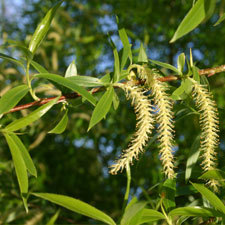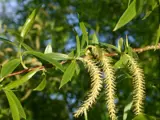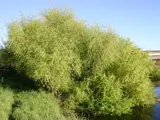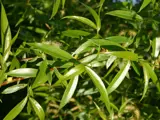 Crack willow
Crack willow
Common name: Crack willow
Botanical name: Salix x fragilis
Management programme: Advisory
Originates from Europe and Western Asia. Introduced to New Zealand for erosion control of rivers and other waterways. Shoots snap with an audible crack, hence the name ‘crack’ willow. Naturalised in New Zealand in 1880.
Why is it a pest?
The plant has a re-sprouting and suckering habit, and with rapid growth it creates dense thickets, replacing native riparian species and blocking waterways.
Where is it found?
- Found in waterways, ponds, lake sides, and other damp habitats.
- Shoots are easily broken, and will readily reshoot to block drains, streams, and culverts.
- Stem fragments are spread by water and suckers spread locally.
- Crack willow is also intentionally planted on river and stream banks for erosion protection.
- Crack willow is widespread throughout the Bay of Plenty.
What does it look like?
- Deciduous tree up to 25m with spreading branches rather than hanging or drooping ones and rough, fissured bark.
- Only male catkins present, 4–7.5cm long, cylindrical, curving or spreading down.
- Flowers September to October.
- Fruit is not formed in New Zealand as female plants are rare or not present.
- Leaves are lance-shaped (5–15cm long and 1–2.5cm wide) with tiny serrations, deciduous, and shiny on the upper surface, hairless underneath with a bluish tinge.
- Leaves often have red galls on them formed by the willow sawfly.
- Root suckers and rootlets form a mass and are bright red when in or near water.
What are the rules?
Advisory
The Bay of Plenty Regional Council does not enforce the control of Advisory species. It is landowner/occupier responsibility to manage these pests. Council may provide advice on how to manage or control these species if required.
How do you get rid of it?
Recommended:
- Hand-pull small plants, ensuring all parts are removed.
- Stem frill and inject with herbicide summer to autumn.
- Stump treatment with herbicide summer to autumn.
- Spray with herbicide and penetrant when in full leaf ensuring full coverage.
Other:
Trees should not be felled unless plant material can be disposed of. They are best treated standing. Control should begin at the top of the catchment.
CAUTION: When using any herbicide or pesticide, PLEASE READ THE LABEL THOROUGHLY to ensure that all instructions and directions for the purchase, use and storage of the product, are followed and adhered to.
Read more on pest control advice, information and regulations
Images



